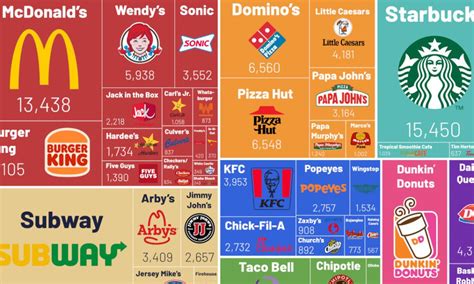
Walmart is set to elevate its in-store dining options by introducing premium fast-food restaurants in select locations across six states. The retail giant is partnering with leading fast-casual brands, including Domino’s, Taco Bell, and Jersey Mike’s, aiming to enhance the shopping experience and draw more customers through its doors.
Walmart is diversifying its in-store dining options by incorporating recognizable fast-food chains in multiple locations across six states, replacing traditional McDonald’s restaurants and other food service offerings. The move aims to attract a broader customer base, enhance the overall shopping experience, and increase revenue through strategic partnerships with popular brands such as Domino’s, Taco Bell, and Jersey Mike’s. This initiative reflects Walmart’s commitment to evolving with changing consumer preferences and leveraging its expansive retail footprint to offer added value to its customers.
According to a recent report, these partnerships are being rolled out in select Walmart stores across Arkansas, California, Florida, South Carolina, Pennsylvania, and Texas. The strategic shift marks a significant change in Walmart’s approach to in-store dining, moving away from relying solely on McDonald’s, which has been a staple in many of its stores for decades.
“We are always looking at ways to enhance our customer experience, and we are excited to bring these new food options to our stores,” stated a Walmart spokesperson. “These partnerships allow us to offer our customers a variety of high-quality, convenient meals while they shop.”
The transition reflects Walmart’s broader strategy to modernize its stores and adapt to changing consumer tastes. By incorporating well-known and respected fast-food chains, Walmart hopes to create a more appealing and comprehensive shopping environment.
Strategic Rationale
Walmart’s decision to diversify its in-store dining options is driven by several strategic factors. First, consumer preferences have shifted towards higher-quality, fast-casual dining experiences. By partnering with Domino’s, Taco Bell, and Jersey Mike’s, Walmart aims to cater to these evolving tastes and attract customers who may have previously chosen to dine elsewhere.
Second, the move is designed to boost foot traffic and increase overall sales. The presence of popular fast-food chains can serve as a draw for customers, encouraging them to spend more time and money in the store. This is particularly important as Walmart faces increasing competition from online retailers and other brick-and-mortar stores.
Third, the partnerships offer a mutually beneficial arrangement for both Walmart and the fast-food chains. Walmart benefits from the increased foot traffic and enhanced customer experience, while the fast-food chains gain access to Walmart’s vast customer base and retail infrastructure.
Impact on McDonald’s
The move raises questions about the future of McDonald’s presence within Walmart stores. While Walmart has not announced a complete removal of McDonald’s restaurants, the introduction of competing fast-food chains signals a potential shift away from its long-standing reliance on the golden arches.
“McDonald’s has been a valued partner for many years, and we continue to have a strong relationship with them,” the Walmart spokesperson clarified. “However, we believe that offering a wider variety of dining options will better serve our customers’ needs.”
McDonald’s has yet to release an official statement regarding the situation, but industry analysts suggest that the company may need to reassess its strategy for maintaining its presence in Walmart stores.
Partnership Details
The specific terms of Walmart’s partnerships with Domino’s, Taco Bell, and Jersey Mike’s have not been publicly disclosed. However, it is likely that the agreements involve revenue-sharing arrangements and operational guidelines to ensure consistent quality and service.
Domino’s, known for its pizza delivery and carryout services, will offer a streamlined menu of its most popular items, including pizzas, sides, and desserts. Taco Bell, a leading Mexican-inspired fast-food chain, will provide a selection of its signature tacos, burritos, and other menu items. Jersey Mike’s, a popular sub sandwich chain, will offer its freshly sliced subs and other deli-style items.
The selected Walmart stores will undergo renovations to accommodate the new fast-food restaurants. These renovations will include dedicated seating areas, ordering kiosks, and kitchen facilities to ensure efficient and convenient service.
Consumer Reactions
Early reactions to Walmart’s announcement have been largely positive. Customers have expressed excitement about the prospect of having more diverse and higher-quality dining options available while they shop.
“I think it’s a great idea,” said one Walmart shopper. “Sometimes I get hungry while I’m shopping, and it would be nice to have something other than just a McDonald’s to choose from.”
Another customer added, “I love Jersey Mike’s, so I’m really excited to see them coming to Walmart. It will definitely make my shopping trips more enjoyable.”
However, some customers have expressed concerns about potential price increases and longer wait times. Walmart has assured customers that it will work closely with its fast-food partners to ensure that prices remain competitive and service is efficient.
Industry Analysis
Industry analysts view Walmart’s move as a smart and strategic decision. They believe that the partnerships will not only enhance the customer experience but also help Walmart differentiate itself from its competitors.
“Walmart is clearly recognizing the importance of offering a comprehensive shopping experience,” said one retail analyst. “By incorporating popular fast-food chains, they are making their stores more attractive and convenient for customers.”
Another analyst added, “This is a win-win situation for both Walmart and the fast-food chains. Walmart gets increased foot traffic and enhanced customer loyalty, while the fast-food chains gain access to a large and captive audience.”
The trend of retailers partnering with fast-food chains is not new. Several other retailers, including Target and Kroger, have also incorporated fast-food restaurants into their stores. However, Walmart’s scale and reach give its partnerships the potential to have a significant impact on the fast-food industry.
Future Expansion
Walmart has not announced any specific plans for expanding the initiative beyond the initial six states. However, the company has indicated that it will closely monitor the performance of the new fast-food restaurants and consider expanding the program to other locations if it proves successful.
“We are committed to providing our customers with the best possible shopping experience, and we will continue to explore new ways to enhance our stores,” the Walmart spokesperson said. “If these partnerships prove to be successful, we will definitely consider expanding them to other locations.”
The future of Walmart’s in-store dining options remains uncertain, but the company’s decision to partner with Domino’s, Taco Bell, and Jersey Mike’s signals a clear commitment to evolving with changing consumer preferences and enhancing the overall shopping experience. This move is likely to have a ripple effect throughout the retail and fast-food industries, as other companies look to emulate Walmart’s success.
Detailed State-by-State Breakdown
- Arkansas: Being Walmart’s home state, Arkansas is a key location for piloting new initiatives. The specific Walmart stores in Arkansas selected for the program have not been disclosed, but the inclusion of Domino’s, Taco Bell, and Jersey Mike’s is expected to cater to a diverse range of tastes. The presence of these popular chains will likely enhance the shopping experience for local customers and increase foot traffic.
- California: California, known for its diverse culinary scene, is a strategic location for Walmart to test its new dining options. The selection of Walmart stores in California will likely consider factors such as demographics and local preferences to maximize the success of the partnerships. The introduction of Domino’s, Taco Bell, and Jersey Mike’s is expected to resonate well with California consumers who value convenience and quality.
- Florida: Florida’s large population and tourist industry make it an attractive market for Walmart. The specific Walmart stores in Florida selected for the program will likely be located in high-traffic areas to capture a significant share of the market. The presence of Domino’s, Taco Bell, and Jersey Mike’s is expected to appeal to both local residents and tourists seeking quick and convenient meals.
- South Carolina: South Carolina represents a growing market for Walmart, with an increasing number of consumers seeking value and convenience. The selected Walmart stores in South Carolina will likely be chosen based on their potential to attract a diverse customer base. The addition of Domino’s, Taco Bell, and Jersey Mike’s is expected to enhance the shopping experience and increase customer loyalty.
- Pennsylvania: Pennsylvania’s diverse demographic profile makes it a valuable test market for Walmart’s new dining options. The selected Walmart stores in Pennsylvania will likely be located in areas with a mix of urban and suburban residents. The introduction of Domino’s, Taco Bell, and Jersey Mike’s is expected to cater to a wide range of tastes and preferences.
- Texas: Texas, with its large population and strong economy, is a crucial market for Walmart. The selected Walmart stores in Texas will likely be located in high-growth areas to maximize the impact of the partnerships. The presence of Domino’s, Taco Bell, and Jersey Mike’s is expected to appeal to Texan consumers who appreciate quality and convenience.
The Broader Context of Retail Partnerships
The collaboration between Walmart and these fast-food chains underscores a broader trend in the retail industry: the integration of complementary services to enhance the overall customer experience. This trend is driven by several factors, including increasing competition from online retailers, changing consumer preferences, and the desire to create a more immersive and engaging shopping environment.
- Enhancing Customer Experience: Retailers are increasingly recognizing that the customer experience is a key differentiator in today’s competitive market. By offering a range of services and amenities, such as fast-food restaurants, retailers can create a more convenient and enjoyable shopping environment that encourages customers to spend more time and money in their stores.
- Driving Foot Traffic: The integration of complementary services can also help retailers drive foot traffic and increase overall sales. Fast-food restaurants, in particular, can serve as a draw for customers who may have previously chosen to shop elsewhere. By partnering with popular fast-food chains, retailers can attract a wider range of customers and increase the likelihood that they will make additional purchases while in the store.
- Adapting to Changing Consumer Preferences: Consumer preferences are constantly evolving, and retailers must adapt to stay relevant. In recent years, there has been a growing demand for convenience and quality in the fast-food industry. By partnering with leading fast-food chains, retailers can cater to these evolving tastes and attract customers who are seeking a more convenient and enjoyable dining experience.
- Creating a Mutually Beneficial Relationship: Retail partnerships can be mutually beneficial for both the retailer and the fast-food chain. The retailer benefits from increased foot traffic and enhanced customer experience, while the fast-food chain gains access to a large and captive audience. This can lead to increased sales and brand awareness for both parties.
Challenges and Opportunities
While the partnership between Walmart and Domino’s, Taco Bell, and Jersey Mike’s offers numerous potential benefits, it also presents several challenges and opportunities.
- Maintaining Quality and Consistency: One of the biggest challenges will be maintaining the quality and consistency of the fast-food offerings. Walmart will need to work closely with its partners to ensure that the food is prepared and served to the same standards as in standalone restaurants. This will require careful attention to detail and ongoing monitoring of quality control measures.
- Managing Customer Expectations: It will also be important to manage customer expectations. While customers may be excited about the prospect of having more diverse dining options, they will also expect the same level of service and convenience that they would receive in a standalone restaurant. Walmart will need to ensure that its fast-food partners are adequately staffed and equipped to handle the anticipated demand.
- Competing with Existing Food Service Offerings: The new fast-food restaurants will also need to compete with Walmart’s existing food service offerings. Walmart currently offers a range of food items, including snacks, drinks, and prepared meals. The new fast-food restaurants will need to differentiate themselves from these offerings by providing a higher-quality and more convenient dining experience.
- Expanding the Partnership: If the initial partnership proves successful, there is a significant opportunity to expand the program to other Walmart stores across the country. This could involve adding more fast-food chains or expanding the menu offerings of existing partners. The potential for growth is significant, and Walmart could become a major player in the fast-food industry.
- Leveraging Technology: Technology can play a key role in enhancing the customer experience and improving operational efficiency. Walmart could leverage mobile ordering, self-service kiosks, and other technologies to make it easier for customers to order and pay for their food. This could help to reduce wait times and improve overall customer satisfaction.
Expert Opinions and Analysis
Industry experts and analysts have offered a range of opinions on the partnership between Walmart and Domino’s, Taco Bell, and Jersey Mike’s.
- Neil Saunders, Managing Director of GlobalData Retail: “This is a smart move by Walmart. It allows them to offer customers a more convenient and enjoyable shopping experience, which is increasingly important in today’s competitive market. The addition of well-known fast-food chains will help to drive foot traffic and increase overall sales.”
- Michael Dart, Partner at A.T. Kearney: “Walmart is recognizing that the customer experience is a key differentiator. By partnering with popular fast-food chains, they are making their stores more attractive and convenient for customers. This is a win-win situation for both Walmart and the fast-food chains.”
- Brittain Ladd, Supply Chain and Logistics Consultant: “The partnership between Walmart and Domino’s, Taco Bell, and Jersey Mike’s is a sign of the changing retail landscape. Retailers are increasingly looking for ways to integrate complementary services and enhance the overall customer experience. This is a trend that is likely to continue in the years to come.”
- Katie Denis, VP of Research & Industry Insights at the Consumer Brands Association: “For consumers, the convenience of having food options while they are shopping creates a value proposition that could increase brand loyalty, while it can also benefit the food industry brands by exposing them to new customers.”
Conclusion
Walmart’s strategic move to incorporate premium fast-food restaurants into its stores reflects a broader industry trend of enhancing the customer experience and adapting to changing consumer preferences. By partnering with well-known brands like Domino’s, Taco Bell, and Jersey Mike’s, Walmart aims to attract a wider customer base, increase foot traffic, and ultimately boost sales. While challenges remain in maintaining quality and managing customer expectations, the potential benefits of this partnership are significant. As Walmart monitors the performance of these new dining options, the company may consider expanding the program to other locations, further solidifying its position as a leader in the retail industry. This initiative highlights the evolving nature of retail, where convenience, variety, and a comprehensive shopping experience are increasingly valued by consumers.
Frequently Asked Questions (FAQ)
1. Why is Walmart adding premium fast-food restaurants to its stores?
Walmart is adding premium fast-food restaurants to enhance the customer shopping experience, attract more customers, and diversify its in-store dining options. This strategic move is intended to cater to evolving consumer preferences for higher-quality, convenient meals while shopping. By partnering with popular brands like Domino’s, Taco Bell, and Jersey Mike’s, Walmart aims to create a more appealing and comprehensive shopping environment, ultimately boosting foot traffic and sales.
2. Which fast-food chains are partnering with Walmart, and in which states?
Walmart is partnering with Domino’s, Taco Bell, and Jersey Mike’s. These restaurants will be located in select Walmart stores across six states: Arkansas, California, Florida, South Carolina, Pennsylvania, and Texas.
3. What will happen to the existing McDonald’s restaurants in Walmart stores?
While Walmart has not announced a complete removal of McDonald’s restaurants, the introduction of competing fast-food chains signals a potential shift away from its long-standing reliance on McDonald’s. Walmart stated that they continue to have a strong relationship with McDonald’s but believe offering a wider variety of dining options will better serve their customers’ needs.
4. How will these new partnerships benefit Walmart customers?
The new partnerships will benefit Walmart customers by providing more diverse and higher-quality dining options while they shop. This enhances the overall shopping experience by offering convenience and variety, allowing customers to enjoy a wider range of meals without leaving the store. It also caters to different tastes and preferences, making shopping trips more enjoyable and efficient.
5. What are the potential challenges Walmart might face with these new partnerships?
Walmart might face challenges in maintaining the quality and consistency of the fast-food offerings across all locations. It’s crucial to ensure that the food is prepared and served to the same standards as in standalone restaurants. Managing customer expectations regarding service speed and quality, competing with existing food service offerings, and integrating the new restaurants seamlessly into the store environment are also potential challenges. Ensuring efficient operations and staffing to handle anticipated demand will be critical for success.









